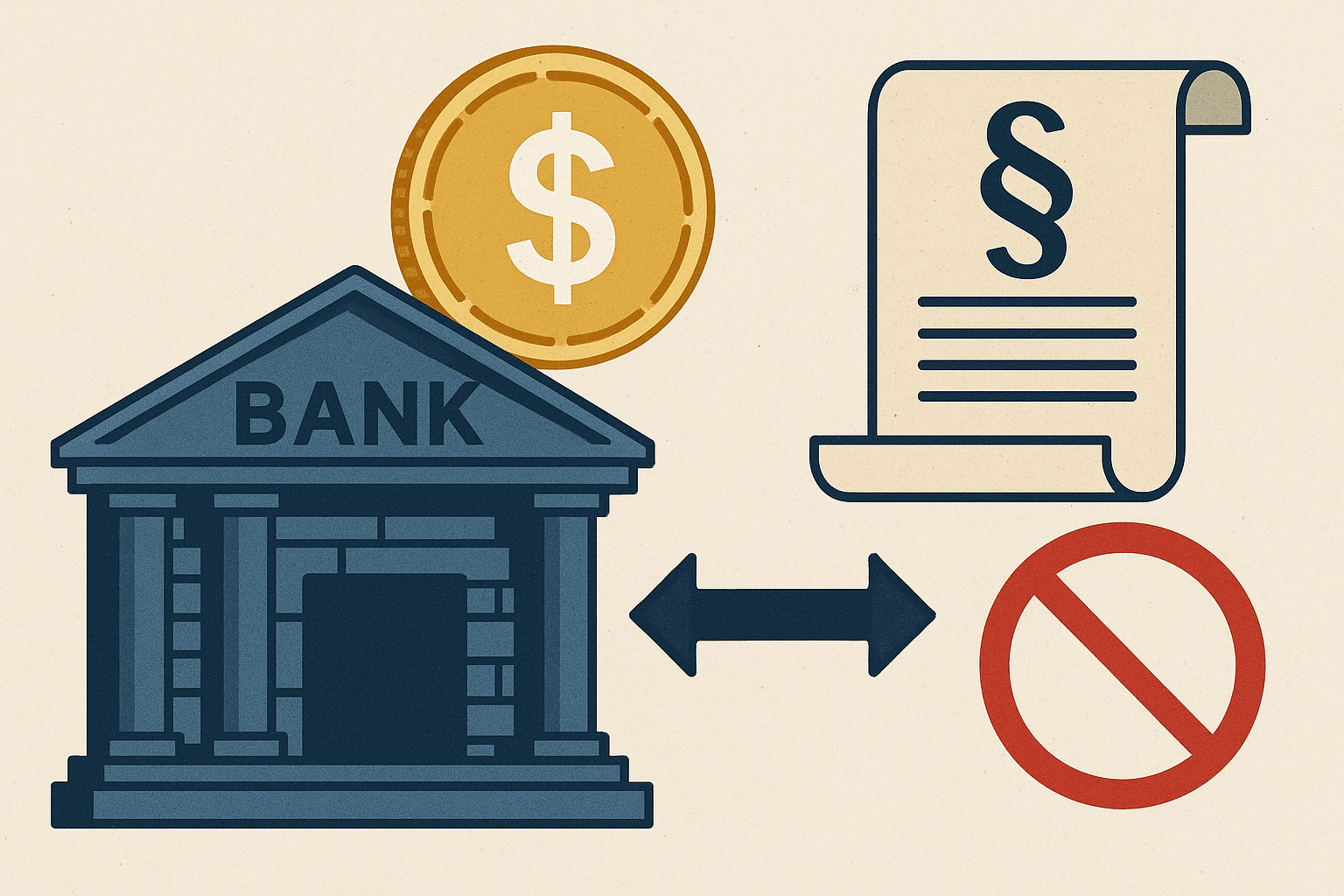The financial world changed forever on July 18, 2025, when President Trump signed the GENIUS Act into law. For the first time in U.S. history, banks and qualified institutions have a clear regulatory pathway to issue payment stablecoins. The Senate passed this landmark stablecoin legislation with a 68-30 vote, establishing federal guardrails for U.S. dollar-pegged stablecoins and creating a regulated pathway for private companies to issue digital dollars.
With the $238 billion stablecoin market now under federal regulation, major players are racing to launch compliant offerings. Deutsche Bank found that stablecoin transactions hit $28 trillion last year, surpassing Mastercard and Visa combined. Corporate giants like Amazon and Walmart are exploring their own stablecoin issuance to save an estimated $14 billion annually in payment processing fees.
But here's what most people are missing: the GENIUS Act gives banks permission to issue stablecoins, but it explicitly prohibits them from making those stablecoins actually useful for business operations.
The GENIUS Act Stablecoin Yield Restrictions: What Banks Can and Can't Do
The GENIUS Act stablecoin regulations create a carefully constructed framework that protects traditional banking while opening new opportunities. Permitted issuers are prohibited from offering payments of interest or yield to holders of payment stablecoins solely in connection with their holding of such payment stablecoins.
This yield-bearing stablecoin ban fundamentally changes the landscape for crypto treasury management and DeFi business banking. Here's exactly what the new stablecoin law allows and restricts:
What GENIUS Act Stablecoin Issuers CAN Do:
✅ Issue regulated, compliant payment stablecoins
✅ Custody stablecoin reserves in Treasury bills and cash
✅ Offer basic stablecoin transfer and payment services
✅ Integrate with traditional banking infrastructure
What GENIUS Act Stablecoin Issuers CANNOT Do:
❌ Offer yield or interest on stablecoin balance
❌ Create programmable payment products with smart contracts
❌ Engage in DeFi strategies for business clients
❌ Build automated treasury management tools
❌ Implement yield-optimized business banking features
This isn't an oversight, it's by design. Speaking at the DC Blockchain Summit in March, US Senator Kirsten Gillibrand said that yield-bearing stablecoins could kill the traditional banking sector. The banking lobby successfully protected their core deposit business model while gaining entry into the regulated stablecoin space.
Corporate Stablecoins and the $14 Billion Payment Processing Opportunity
Meanwhile, corporate America is racing to capitalize on GENIUS Act stablecoin issuance opportunities. Major retailers, including Walmart and Amazon, are reportedly considering their own corporate stablecoin offerings to reduce massive payment processing costs. The Corporate Stablecoin Business Case:
Card processing fees range between 1% and 3% of transaction volume
Walmart and Amazon spend an estimated $14 billion annually on payment processing costs
A 1% reduction would translate to roughly $1 billion in annual EBITDA gains
Other large multinationals, including Expedia Group and major airlines, are exploring similar initiatives
The GENIUS Act regulatory framework provides the legal clarity these corporations need to move forward. However, issuing a compliant stablecoin and building useful stablecoin infrastructure for business operations are two completely different challenges.
The Missing Layer: Programmable Money Infrastructure for Business
The GENIUS Act creates a fundamental gap between what businesses actually need and what regulated stablecoin issuers can provide. Let's examine the difference between GENIUS Act compliance and business stablecoin functionality:
What GENIUS Act Stablecoins Enable for Business:
Issue compliant, reserve-backed corporate stablecoins
Accept stablecoin payments to reduce interchange fees
Settle transactions in seconds vs. days with traditional banking
Maintain full regulatory compliance and consumer protections
Access to regulated custody and basic transfer services
What Businesses Actually Need for Stablecoin Operations:
High-yield business bank accounts with automated DeFi integration
Crypto treasury management with yield optimization
Programmable payment flows for supply chain automation
Smart escrow systems for vendor and contractor payments
Automated payroll with yield-earning float until wages are claimed
Dynamic invoicing with early-payment discounts based on yield potential
Multi-signature treasury operations with programmable spending controls
Stablecoin yield infrastructure for corporate cash management
This gap represents the core opportunity in the post-GENIUS Act stablecoin market: banks can issue compliant stablecoins, but they can't make them operationally useful for business.
Why DeFi Infrastructure Becomes Essential for Corporate Stablecoins
The GENIUS Act's ban on yield-bearing stablecoins is redirecting institutional capital toward decentralized finance (DeFi) platforms and programmable money infrastructure. With no interest incentives left in stablecoins, DeFi becomes the primary option for generating passive income onchain, according to analysts like Nic Puckrin and CoinFund's Christopher Perkins.
Why Corporate Stablecoins Need External DeFi Infrastructure:
Institutional Yield Requirements: Financial institutions have fiduciary duties to generate returns on capital. The limitation creates problems for institutions and sophisticated investors constantly seeking yield-bearing opportunities.
Treasury Optimization Gaps: Corporate stablecoins under GENIUS Act can't optimize yield on reserves, creating demand for external programmable yield infrastructure.
Business Logic Limitations: Regulated stablecoin issuers can't build the smart contract infrastructure businesses need for automated B2B payments, supply chain financing, and treasury management.
Real-World Example: Corporate Stablecoin + Programmable Infrastructure
Consider what this means for a company like Amazon or Walmart issuing their own GENIUS Act-compliant stablecoin:
Phase 1: GENIUS Act Stablecoin Issuance
Amazon issues "AmazonCoin" under federal regulatory compliance
Saves billions in interchange fees by accepting their own stablecoin
Gains instant settlement and reduced payment processing costs
Maintains full reserve backing with Treasury bills and cash
Phase 2: Integration Challenges
5. Cannot offer yield on AmazonCoin balances to corporate treasury
6. Cannot create programmable payment workflows for suppliers
7. Cannot build automated escrow systems for vendor payments 8. Cannot implement smart treasury management features
Phase 3: External Infrastructure Integration
9. Partners with programmable money infrastructure providers like RebelFi
10. Enables yield optimization on corporate stablecoin reserves through DeFi protocols
11. Implements smart escrow systems for supply chain payments
12. Activates automated payroll with yield-earning until wages are claimed
13. Creates dynamic invoicing with yield-based early payment incentives
RebelFi: The Programmable Infrastructure Layer for Corporate Stablecoins
This is exactly the gap that RebelFi's DeFi business banking infrastructure addresses. While banks focus on GENIUS Act compliance and basic stablecoin issuance, RebelFi provides the programmable layer that makes corporate stablecoins operationally transformative for business.
Smart Account Architecture for Corporate Stablecoins
RebelFi's embedded DeFi platform enables GENIUS Act-compliant corporate stablecoins to support:
Crypto treasury management through automated DeFi yield optimization
High-yield business bank accounts with instant yield generation
Programmable escrows
for supply chain and vendor payments
Automated payroll systems with yield-earning float until claimed
Dynamic invoicing with early-payment discounts based on yield potential
Multi-signature treasury operations with programmable spending controls
Stablecoin payment processing with zero-fee models through yield generation
Real-World Corporate Stablecoin Applications
Imagine "WalCoin" or "AmazonCoin" powered by RebelFi's programmable money infrastructure:
Supply Chain Optimization:
Vendor payments that earn yield until claimed, reducing working capital costs
Smart escrow systems for milestone-based contractor payments
Automated B2B invoicing with programmable early-payment incentives
Treasury Management:
Employee payroll where unclaimed wages generate revenue for corporate treasury
High-yield corporate savings through DeFi protocol integration
Automated cash flow optimization with yield-generating float
Customer Operations:
Loyalty programs funded by programmatic yield sharing
Prepaid customer accounts that earn yield until spent
International payments with instant settlement and built-in compliance tracking
The GENIUS Act Partnership Model: Stablecoin Issuers + Infrastructure Providers
The GENIUS Act regulatory framework actually creates the perfect partnership structure for programmable corporate stablecoins:
Corporate Stablecoin Issuers (Amazon, Walmart, major retailers):
Focus on GENIUS Act compliance, reserves, and regulatory requirements
Leverage their massive customer base and transaction scale
Handle basic stablecoin issuance and custody operations
DeFi Infrastructure Providers (RebelFi):
Provide the programmable money layer that makes stablecoins operationally useful
Enable yield optimization, automation, and advanced business logic
Build crypto treasury management and embedded DeFi capabilities
Traditional Banks (custody and compliance partners):
Handle regulatory requirements and reserve management
Provide traditional banking integration and fiat on/off ramps
Ensure GENIUS Act compliance and consumer protections
This specialization model allows each player to focus on their core strengths while creating a more powerful combined offering for business stablecoin adoption.
Why the Infrastructure Opportunity Matters Now
President Trump has signed the GENIUS Act into law, meaning mainstream banks and fintechs will rapidly integrate stablecoins into everyday American business operations. But without programmable infrastructure, these stablecoins will function as little more than digital versions of existing payment rails.
The Market Timing is Perfect:
$238 billion stablecoin market now under clear federal regulation
Corporate stablecoin issuance expected to accelerate rapidly
DeFi adoption surging as institutions seek yield alternatives
Business demand for programmable payment infrastructure growing
The real value opportunity lies in building the programmable money infrastructure that makes GENIUS Act stablecoins yield-generating, automated, and operationally transformative for business operations.
The Network Effect Opportunity in Corporate Stablecoin Infrastructure
Once powerful US financial institutions actively participate in the corporate stablecoin market as regulated issuers, they become vested in promoting and expanding programmable money ecosystems. This creates massive opportunities for DeFi infrastructure providers who can enable cross-stablecoin interoperability and business automation.
Revenue Opportunities Beyond Traditional Payment Processing:
Platform fees for programmable features across multiple corporate stablecoins
Yield sharing on corporate treasury optimization and crypto cash management
Infrastructure-as-a-Service for stablecoin workflow automation
Embedded DeFi licensing for banks and financial institutions
Programmable payment APIs for business application integration
The Network Effects of Corporate Stablecoin Infrastructure:
Multiple corporate stablecoins using shared programmable infrastructure
Cross-stablecoin yield optimization and treasury management
Standardized business logic for automated B2B payments
Unified compliance frameworks across different corporate tokens
The Bottom Line: GENIUS Act Creates the Infrastructure Opportunity
The GENIUS Act stablecoin law is being hailed as a watershed moment for digital assets and it absolutely is. But the real value won't come from banks issuing basic payment stablecoins. The transformative opportunity lies with DeFi infrastructure providers who can make those stablecoins programmable, yield-generating, and operationally revolutionary for business operations.
Key Takeaways for Business Leaders:
Corporate stablecoin issuance will accelerate rapidly under GENIUS Act framework
Regulated stablecoin issuers cannot provide yield or programmable features
External DeFi infrastructure becomes essential for business stablecoin utility
First-mover advantage exists for programmable money infrastructure providers
Partnership models between issuers and infrastructure providers will dominate
The Strategic Opportunity: Banks can issue GENIUS Act-compliant stablecoins, but they legally cannot make them useful for business operations. That's where the trillion-dollar opportunity lies for programmable money infrastructure, and companies building DeFi business banking platforms are perfectly positioned to capture it.
Want to see programmable corporate stablecoins in action? RebelFi's DeFi business banking platform already enables companies to earn yield on every transaction, create smart escrows, and automate treasury operations, the exact capabilities that GENIUS Act stablecoins will need to become truly transformative for business. Learn more about RebelFi's programmable money infrastructure.
Frequently Asked Questions About GENIUS Act Stablecoins
Q: What is the GENIUS Act and when did it become law?
A: The Guiding and Establishing National Innovation for U.S. Stablecoins (GENIUS) Act was signed into law by President Trump on July 18, 2025. It establishes the first comprehensive federal framework for regulating stablecoin issuance in the United States.
Q: Can banks issue stablecoins under the GENIUS Act?
A: Yes, the GENIUS Act allows banks, qualified nonbank entities, and state-regulated issuers to issue payment stablecoins under specific regulatory conditions and federal oversight.
Q: Why can't GENIUS Act stablecoin issuers offer yield?
A: The Act explicitly prohibits stablecoin issuers from offering payments of interest or yield to holders solely for holding stablecoins. This protects traditional banking deposit models while allowing regulated stablecoin issuance.
Q: How will corporate stablecoins work under the GENIUS Act?
A: Companies like Amazon and Walmart can issue GENIUS Act-compliant stablecoins to reduce payment processing fees, but they'll need external infrastructure providers for programmable features like yield optimization and automated business logic.
Q: What's the difference between stablecoin issuance and programmable money infrastructure?
A: Stablecoin issuance involves creating and managing compliant digital tokens. Programmable money infrastructure adds business functionality like yield generation, smart escrows, automated payments, and treasury management, capabilities that GENIUS Act issuers cannot provide directly.
About RebelFi: RebelFi is building programmable infrastructure for corporate stablecoins and digital assets, enabling businesses to earn yield, automate payments, and create smart financial workflows. Our embedded DeFi platform provides the exact capabilities that GENIUS Act stablecoins need to become operationally useful - from instant yield generation to programmable escrows and automated treasury management. Discover how RebelFi bridges the gap between compliant stablecoin issuance and transformative business functionality.



